Peace Dollar Symbolizes America’s Hope for Lasting Peace After WWI
Posted onPresident Woodrow Wilson famously described World War I as the war to end all wars.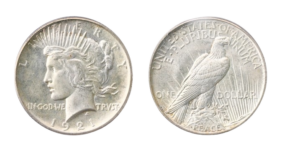
After a bloody four-year conflict, from 1914-1918, in which over 8 million soldiers and sailors died, the Allied Forces and the Germans signed an armistice ending World War I on November 11, 1918.
After the war ended, the American numismatic community advocated for an official coin to celebrate the peace. Soon after, a design competition for the new coin was announced. A 34-year old Italian sculptor named Anthony de Francisci won the honor of designing this important coin.
The coin’s design elements were carefully chosen to represent peace, harmony and optimism and are treasured by collectors everywhere today as a tribute to WWI and the restoration of peacetime that followed.
The inspirational Peace dollar features a portrait of Miss Liberty facing left with a serene expression on her face, with flowing hair and a radiating crown. The word LIBERTY encircles her crown, and IN GOD WE TRUST and the date lie below. The image represented Americans desire to look ahead.
The reverse of the silver Peace Dollar features a bald eagle, resting on a rock, clutching an olive branch above the word “PEACE.” Rays of sunlight brighten the background. This was one of two designs considered, with the first being a more aggressive representation of the eagle, holding a broken sword. Ultimately, the sword remained but was place beneath the eagle. However, the response to the broken sword was swift and loud. “A sword is broken when its owner has disgraced himself. It is broken when a battle is lost and breaking is the alternative to surrendering. A sword is broken when the man who wears it can no longer render allegiance to his sovereign. But America has not broken its sword. It has not been cashiered or beaten; it has not lost allegiance to itself. The blade is bright and keen and wholly dependable.”
The silver Peace Dollar minted between 1921 and 1935 represents one of the most celebrated and lasting designs in numismatics. It’s calming beauty and its symbolic message along with its unique status as our country’s last circulating silver dollar make it a highly sought after coin series among collectors.
The Peace dollar was issued under the terms of the Pittman Act. That act required the U.S. Mint to strike millions of silver dollars, which began in 1921 initially using the Morgan dollar design. Treasury Secretary Andrew Mellon approved the Peace dollar in December 1921.
While just over one million 1921 $1 High Relief Peace dollars were minted in Philadelphia, the majority met their fate in the melting pot. The high relief was deemed impractical for coinage and was quickly modified to “low relief” in 1922.
Today, the first-year 1921 is one of the scarcest Peace dollars in both circulated and mint state condition. This coin is considered a very important one-year-only silver type coin.
The Peace Dollar series also boasts some intrigue notably around the 1964-D Peace Dollar. U.S. Mint records show that 316,076 silver Peace dollars were struck at the Denver Mint in May of 1965 (though they were backdated to 1964).
At the time, a massive silver shortage meant these Peace dollars were significantly more valuable for their silver content than their $1 face value. Indeed before these coins were even released to the public, private collectors were advertising offers of $7.50 each to buy the coins!
The government was concerned about the potential for public hoarding and the silver Peace dollar program was cancelled. What about those 1964-D Peace Dollars? They were never released to the public and condemned to the melting pot.
What’s more, today, it is illegal to possess a 1964-dated Peace dollar! So do any still exist today? According the official story, at the time, all but two of the 1964 Peace Dollars were melted down for their silver content. The two survivors were reportedly sent to Washington, D.C., where they remained until 1970 when Mint records say they too were melted in the presence of a destruction committee.
However, within the numismatic community there are stories.
It was said that every Denver Mint employee received two coins each. But even if a 1964 Peace Dollar were found today, it would be illegal to own since the coin was never officially monetized.
Today the Peace Dollar is a tangible piece of American history that represents America’s desire for healing and renewal after the Great War. The Peace Dollar has become a powerful and enduring symbol of America’s post-war spirit and America’s desire for lasting peace. Curious? We have just one example of a certified 1921 MS-64 Peace dollar, see it here.
Want to read more? Subscribe to the Blanchard Newsletter and get our tales from the vault, our favorite stories from around the world and the latest tangible assets news delivered to your inbox weekly.
Gold Jumps to A Four Week High After December Jobs Report
Posted onU.S. stocks plunged and gold climbed to a four-week high after a blow-out December jobs report on January 10. The Dow sank nearly 700 points as investors fled the equity markets following news that the U.S. economy added 256,000 new jobs in December, far outpacing estimates of around 165,000 jobs.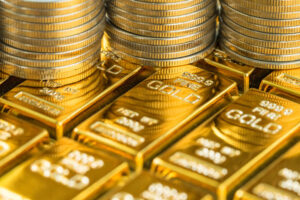
Investors once again turned to the safety of gold as expectations the Federal Reserve will not reduce interest rates as much as previously expected took the wind out of the stock market’s sails.
Overall, investors dumped stocks amid concerns that the job market would add more inflation to the economy at a time when the Fed has failed to get prices under control. The December jobs report reinforced expectations that the central bank will keep interest rates unchanged when it meets next at the Jan. 28-20 meeting. The markets are pricing in a 94% chance that the Fed holds rates steady when it meets in late January, according to the CME Fedwatch Tool.
The unexpected strength in the jobs report spooked stocks on a couple of fronts and reveals how the equity market is on weak footing. Stock investors are worried both about inflation and that higher interest rates are here to stay for longer, which weighs on stocks.
Stock investors may want to prepare for increased stock volatility in the weeks and months ahead as the Fed has fewer reasons to cut interest rates this year.
Meanwhile, gold is flexing its strength and racing out of the starting gates in 2025 trading near $2,700 an ounce, following the precious metals’ stunning 26% gain last year. Gold settled at their highest level in four weeks in the week ending January 10, despite gains in the U.S. dollar and Treasury yields.
The great gold rally of 2024 is continuing at full speed ahead as worries about the U.S. fiscal situation continue to support inflows into safe-haven, tangible assets like precious metals. With the U.S. debt levels climbing to $36.3 trillion and as a percentage of our gross domestic product is nearly 125%. Worries about the rising debt and the potential for a debt crisis are resulting in higher Treasury yields as bond investors demand higher returns relative to the risk that government bonds represent.
In today’s uncertain world, gold continues to tower among other asset classes in terms of safety and security. Gold ownership provides peace of mind as it allows you to preserve, protect and grow your wealth just it has for the past 5,000 years.
Want to read more? Subscribe to the Blanchard Newsletter and get our tales from the vault, our favorite stories from around the world and the latest tangible assets news delivered to your inbox weekly.
California Territorial Gold: Prized By Collectors around the World
Posted onIt was January 24, 1848. At Sutter’s Mill in California, James Marshall was doing his daily inspection for the sawmill he was building. He found shining flecks of metal amid loose dirt and gravel after he diverted water to clean up the construction site. Marshall showed it to his crew and everyone was fairly certain it was gold. However, Marshall unaware of the significance of his discovery was focused on completing the sawmill on schedule.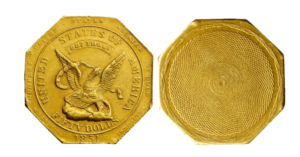
Marshall had no idea what his discovery was about to unleash.
Today, historians consider the California gold rush to be one of the most significant events of the first half of the 19th century. Marshall’s discovery of gold triggered the largest migration in United States history as over 300,000 flocked to the California territory in search of riches and wealth.
These were exciting and rough and tumble times in the California territory. While miners pulled gold nuggets out of rivers and the ground, the raw gold was not effective as a medium of exchange. And, there was no way to turn that into coins in the west at that time. The first California branch of the U.S. Mint didn’t open until 1854.
The fortune hunters who flocked to the California territory desperately needed coins to pay for everyday goods and services. At that time, people used pinches of gold dust to pay for merchandise and services. However, this method lacked uniformity and an extra big pinch from a merchant could be costly.
There were proposals to use paper currency to ease the coin shortage. But, the people who had journeyed to the West had a deep distrust of paper money. They wanted gold coins. Indeed, Article IV section 34 of the 1849 California Constitution outlawed the right for any bank to “make, issue, or put in circulation, any bill, check, ticket, certificate, promissory note, or other paper, or the paper of any bank, to circulate as money.” Simply put, the people wanted hard currency.
So, entrepreneurs of the day seized the opportunity and opened private mints. Private gold was circulated out of necessity in the rural West due to the coin shortages.
The First Private Gold Mint in California
At that time, in New York City, a firm called Norris, Gregg & Norris specialized in manufacturing items like metal pipes, fittings, and boilers that were used in plumbing and steam-heating of buildings. Following the 1848 discovery of gold at Sutter’s Mill, the enterprising partners— Thomas H. Norris, Hiram A. Norris, and Charles Gregg—relocated to California and formed a private mint.
In the spring of 1849 Norris, Gregg & Norris began minting the first private gold ever in the region, including several varieties of $5 gold pieces with both plain and reeded edges.
It made the local news. The Alta California newspaper reported: “We have in our possession a Five Dollar gold coin, struck at Benicia City, although the imprint is San Francisco. In general appearance it resembles the United States coin of the same value.”
Moffat & Co. Was Known for Meticulous Production of Its Gold Coins
In 1850, California became the 31st state to join the Union in September and at that time private minting was legal. Not only was the private issuance of money was common – indeed it was essential.
Moffat & Co. was founded by New York metallurgist John Little Moffat. His firm developed an assay office, which was semi-official in appearance and character, despite having no official connection to the United States government.
Moffat used U.S. American gold coins as a model for some of his coins. He employed Albrecht Kuner, a skilled Bavarian to create the dies for the five and ten dollar pieces. The dies were every bit as elaborate as official government coins. On the coronet of Liberty, the words Moffat & Co. replace the word LIBERTY, which was seen on official United States government coins.
Many of Moffat’s coins, including the 1850 $5 Gold Moffat coin are enduring pieces of numismatic history. Moffat & Co. was the considered most reputable and influential private gold minter of the California Gold Rush period.
Moffat $5 coins were heavily used in the gold camps. Later, many were melted down for the gold content. Today an 1850 $5 Gold Moffat in mint condition is considered very rare and a highly coveted prize for collectors.
Once the federal government decided to open a mint in California it leaned heavily on Moffat for guidance, support and advice. In fact, the successors of the firm eventually sold their minting facility to the U.S. Treasury department.
Eight-Sided Humbert Gold Piece Represents the Best of Gold Rush History
The significance of the 1851 Humbert $50 coin can hardly be exaggerated. This iconic eight-sided gold piece represents the best of the legendary California Gold Rush period.
The hugely popular $50 “slug” was designed by Augustus Humbert, a New York watchmaker. Humbert developed the obverse and reverse dies for his proposed $50 ingots and transported them across the country to California along with other necessary equipment. In 1851, he joined up with Moffat & Co. to produce these remarkable coins under government contract as the United States Assay Office of Gold.
The survival rate of the Humbert fifties is low, especially in a high grade. Once the U.S. Mint finally opened in California, many of these gold pieces ended up in the melting pots due to their high intrinsic value.
The Humbert $50 ingot’s memorable octagonal design features an eagle with a U.S. shield and three arrows in the right talon on the reverse. A scroll inscribed LIBERTY sits in the beak and UNITED STATES OF AMERICA and FIFTY DOLLS surrounds the eagle. Around the edge it reads AUGUSTUS HUMBERT UNITED STATES ASSAYER OF GOLD CALIFORNIA 1851. A unique “Target” pattern fills the reverse.
Wass and Molitor Gold Pieces
Samuel C. Wass and Agoston P. Molitor, Hungarian immigrants who had studied metallurgy in Germany, saw the private minting opportunity and they jumped on it. The team opened an assay office on Montgomery Street in San Francisco in October, 1851. It didn’t take long before the hardworking pair developed an extensive smelting operation and assay laboratory that was publicly lauded in the local newspapers for its modernity.
In 1852, Wass, Molitor & Co opened for business and began minting ore into small denominations like $5 and $10 gold pieces. The public quickly embraced Wass and Molitor’s coinage. Their coins were considered good quality and miners who brought in nuggets and gold dust received fast service – their ore was turned into coins within 48 hours! Eventually, their gold pieces demanded a premium in circulation and were eagerly accepted in trade.
By 1855 Wass and Molitor began coining $20 and $50 gold pieces. The 1855 $50 Wass and Molitor gold piece is the largest coin their firm it had ever made – indeed a weighty, round $50 gold coin. The round $50 gold pieces remained popular and widely circulated until the San Francisco Mint began striking federal coins in a consistent fashion. By the end of 1855, the private coin firms were no longer needed and Wass, Molitor & Co. shut down.
Due to their hefty gold content, many of Wass Molitor coins were melted by the San Francisco branch mint to turn into federal coinage, which makes survivors especially in high grades extremely rare.
The End of an Era
The San Francisco Mint began operations in 1854. This stopped private gold coinage and marked the end of an extraordinary era for California territorial gold. The surviving private gold coins are bursting with history of a dramatic and exciting era in Western gold rush history.
Today, these highly sought after large Territorial coins are hard to come by and it can be decades before high quality specimens surface. Once these legendary and iconic coins change hands, collectors tend to hold onto them for years or even a lifetime. Wouldn’t you?
How You Can Protect Yourself Before The Next Stock Bubble Bursts
Posted onThroughout history, bubbles have formed in stocks, real estate and even tulip markets. Indeed, financial history keeps repeating itself. Bubbles form, grow and then burst with disastrous consequences over and over again.
Investors who are participating in the market run-up typically believe that if anything goes wrong, they can be safely one of the first people out the door. But, since bubbles are fueled by psychology—the fear of missing out—and also greed, getting out at the right time is a challenging maneuver that few succeed at.
There’s an old saying in the stock market, bull markets climbing higher take the stairs, but bear markets that are tanking take the elevator down. When stocks plunge, panic selling drives prices down fast. That makes it hard to get out.
The outcome of a bubble is always the same. Bubbles end badly, with financial losses far exceeding what investors thought could be possible.
Why are some experts sounding the alarm bell right now on stocks? Simply put, market valuations are historically overpriced and overstretched.
At the recent S&P 500 peak, Nobel prize winning economist Robert Shiller’s price/earnings ratio (CAPE) was the second highest ever—going all the way back to 1870.
These are the type of signals that occurred before major stock market plunges, which saw the market dive 50% or more in 1973-1974, 2000-2002 and 2007-2009.
If you have a $1 million stock portfolio—how would you feel if that were cut in half to $500,000 by December 2025?
There is a way that you can decrease your risk before the next bubble bursts.
Increase your allocation to gold right now.
Book some of those profits in your stock market portfolio and use those proceeds to purchase a tangible asset like gold or silver.
Precious metals act as an insurance policy, a hedge against equity market declines and as a vehicle to protect and grow wealth. This paid off for gold investors after the 2008 global financial crisis when gold went from $700 to $1,900 an ounce.
Gold and silver have stood the test of time, providing people for thousands of years with a store of value that not only protects and preserves wealth, but helps to grow it. The great gold rally is far from over. Gold broke records last year and is expected to set new records in 2025.
How much is gold enough? That is a personal question based on your risk tolerance level and there are a range of answers:
- Billionaire investor Ray Dalio recommends investors to own up to 15% of their wealth in gold saying: “if you don’t own gold, you know neither history or economics.”
- Research from the well-respected CPM Group stated that over the past 50 years, the best return of a portfolio including stocks, bonds, and gold was for portfolios that had around 25% – 30% of their value in gold.
As the calendar flips to 2025, the stock market rally is frothy and living on fumes. If you take action now, you can protect your wealth before the next stock market bubble bursts. Now’s the time to buy if you’ve been waiting to increase your allocation to gold, with $3,000 an ounce as the next big target on the upside.
Gold’s role as currency and as an asset to protect, preserve and grow your wealth has lasted for centuries and shows no signs of losing its appeal. If you have been thinking about increasing your allocation to gold, there’s never been a better time. It’s easy to increase your wealth protection, why not do it today? When the stock market begins to tank, you’ll be glad you did.
Want to read more? Subscribe to the Blanchard Newsletter and get our tales from the vault, our favorite stories from around the world and the latest tangible assets news delivered to your inbox weekly.
2024: An Extraordinary Year for Precious Metals
Posted onGold and silver delivered extraordinary performances in 2024. It was a record-breaking year as gold climbed to multiple new all-time highs throughout the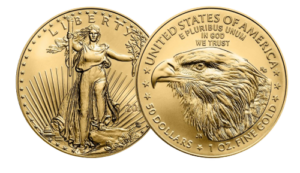 year. Gold’s remarkable ascent to a new record above $2,700 an ounce was driven by multiple factors including central bank buying, geopolitical tensions, monetary policy easing, persistent inflation, and increased safe-haven demand from investors.
year. Gold’s remarkable ascent to a new record above $2,700 an ounce was driven by multiple factors including central bank buying, geopolitical tensions, monetary policy easing, persistent inflation, and increased safe-haven demand from investors.
Precious metals outpaced returns in most other asset classes. Gold climbed as much as 33% annually through the fourth quarter, while silver gained 29%.
Key Bullion Trends in 2024
Several factors contributed to gold’s stellar performance in 2024 including aggressive central bank buying, geopolitical tensions around the globe, stubborn inflation and monetary easing.
- De-Dollarization: The geopolitical landscape, particularly actions such as the freezing of Russia’s dollar assets by the Biden administration, prompted countries to reconsider the amount of their reserves held in dollars. This contributed to the increased demand for gold as a secure, long-term reserve internationally.
- Long-term Position Building: Central banks are buying and stockpiling gold, and these are long term positions. This trend emerged amid a fundamental shift in how central banks manage the composition of their reserves. Notably, they are decreasing their U.S. dollar reserves and increasing their gold reserves. Central banks like Russia, along with emerging markets like China, India, and Turkey, have been significant buyers of gold recently. This increase in central bank gold holdings has created a strong stable base for gold prices at these higher prices levels. Central banks are the ultimate buy and hold investors, and tend to hold their assets for decades.
- Geopolitical Tensions: Ongoing conflicts in Ukraine and the Middle East, coupled with broader global uncertainties, heightened gold’s appeal as a safe-haven asset.
- Monetary Policy Shifts: Federal Reserve and other central bank’s interest rate cuts in 2024 boosted gold’s attractiveness. As interest rates decrease, non-yielding assets like gold become more appealing to investors.
- Inflation Concerns: Persistent inflationary pressures in many economies, including the United States, increased investor interest in gold as a method to protect and preserve the purchasing power of their wealth.
- Strong Investor Demand: The record-breaking performance of gold in 2024 attracted more investors into bullion, creating a self-reinforcing cycle of demand. As prices climbed, more investors entered the market, further driving up prices.
Investor Behavior: Fractional Gold Emerged As a Popular Bullion Strategy in 2024
Over the past year, new and seasoned investors actively accumulated fractional gold in a long-term wealth building strategy. There has been significant focus on fractional gold, which is seen as a practical, affordable, and the perfect emergency-use currency.
These smaller denominations of gold, typically weighing less than one ounce, provide a more accessible entry point into the precious metals market. One of the benefits of fractional gold is its affordability. With options like 1/10 oz, 1/4 oz, and 1/2 oz coins investors can build their bullion portfolios on an on-going basis, over time, using a strategy known as dollar-cost averaging.
Another benefit to fractional gold is increased liquidity—as smaller denominations are seen as easier to sell or trade compared to larger coins or bars. This liquidity is a valuable hedge against periods of economic uncertainty or panic—especially as a number of American states advance legislation to recognize gold and silver as legal tender. Already, 12 states have laws on the books that make gold and silver legal tender. Additionally, other states are exploring similar initiatives.
The push for legalizing gold and silver as currency is driven by several factors. Advocates argue that precious metals offer stability in value compared to fiat currencies, which are subject to inflation and economic fluctuations. The growing interest among states suggests that this trend could expand in the coming years as more lawmakers consider alternatives to traditional fiat systems amid economic uncertainties.
Investor Confidence and Wealth Building
Successful wealth building includes taking a long-term view to your investments. As Wall Street legend Ben Graham advised: “The individual investor should act consistently as an investor and not as a speculator.”
Investors are increasingly confident in the stability, peace of mind and wealth preservation opportunities that precious metals offer. Investors view these investments as part of a steady, long-term wealth-building strategy, adding to their portfolios whenever possible. Steady accumulation of bullion has proven to be the most successful approach to building wealth over the long term.
Precious metals have stood the test of time, providing people for thousands of years a store of value that not only protects and preserves wealth, but helps to grow it. The great gold rally is far from over. Gold broke records this year and is expected to set new records in 2025.
If you desire to build wealth for yourself and future generations, Blanchard can help you achieve your goals. Over the past 50 years, we have helped clients invest in American numismatic rarities and investment grade silver, gold, platinum and palladium bullion to protect and grow their wealth. We can help you too.
2024: An Extraordinary Year for U.S. Rare Coins
Posted onThe U.S. rare coin market is closing out a memorable year that will go down in the record books. In 2024, the numismatic market surpassed $6 billion in annual total volume. On a global scale, the coin collecting market was valued at $18.1 billion and is projected to climb to $43.9 billion by 2034, with an 8.5% annual growth rate.
In 2024, the American numismatic market registered a significant pick-up, as overall demand for rare coins rose steadily.
Looking ahead, the rare coin market is poised for continued growth, with supply and demand fundamentals signaling an upward trend in value. As the market expands towards $40+ billion annually in the next ten years, rare coins already in the marketplace are expected to increase in value, driven by the limited supply inherent in the numismatic market. Collecting rare coins has been, and remains, a timeless passion and a prudent investment strategy.
Key Numismatic Trends in 2024
Several notable themes emerged in the numismatic market over the past year.
Tangible Assets Go Mainstream: An influx of new U.S. investors flocked to the numismatic and bullion markets in 2024. Young professionals, in particular, entered the precious metals and numismatic markets, many participating for the first-time. Many of these new investors heard about precious metals and rare coins through conversations with their business associates and friends, as more Americans became comfortable discussing the importance of owning tangible assets.
Increased Inventory Post Covid: A pick-up in transaction activity in the numismatic market occurred in 2024. More rare coins surfaced over the past year after limited inventory during the pandemic and post-pandemic years. In 2024, high-end rarities that emerged from collections for sale, after sitting decades with one owner, were quickly snapped up. As always, when true rarities become available for sale they are placed swiftly and then not seen again for many, many years.
Investors Seeking Diversification and Safety: Investor sentiment focused on economic and political uncertainties, particularly related to the election and long-term financial stability. The recognition that there is no quick fix for the prolonged dollar debasement created the need for sound investment strategies in rare coins and gold.
Generational Wealth Building: A major theme driving investors into coins and precious metals is a desire for a long-term, generational wealth building strategy.
Our Favorite Numismatic Placements in 2024
In the midst of an active year, Blanchard helped thousands of clients put in place investment strategies to preserve, protect and grow their wealth. Here are just a few of our top placements in 2024, including many ultra-rare, capstone coins that rarely surface for sale in the numismatic community.
1.1907 $10 Indian Rolled Edge MS65: This coin represents President Theodore Roosevelt’s initiative to beautify American currency, designed by Augustus Saint-Gaudens. It’s historically significant as the first year of issue for this design and valuable due to its rarity and high grade.
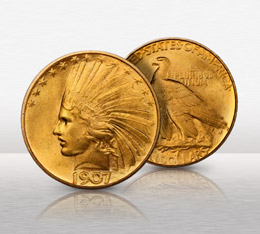
2. 1830 $5 Capped Bust MS65: Produced during a period of technological advancement at the U.S. Mint, its rarity and high grade contribute significantly to its value.
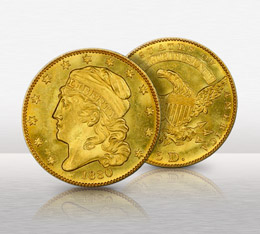
3. 1879 $4 Flowing Hair Stella PR66: This dazzling pattern coin was produced as a potential international trade coin. However, the illustrious $4 gold Stella was never authorized for official use in circulation. Its unique $4 denomination and limited mintage make it highly valuable and iconic for collectors.
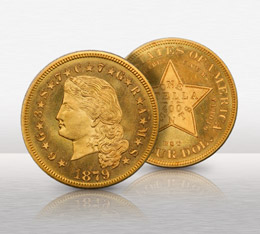
4. 1863 $10 Liberty Ultra Cameo No Motto PR65: Minted during the Civil War, this coin is an extreme rarity, as only nine or ten are known to exist. Its historical context and high-quality Ultra Cameo finish contribute to its desirability.
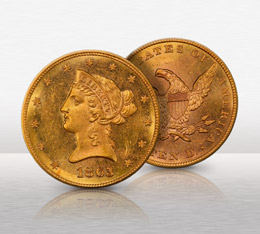
5. 1797 $5 Draped Bust 15 Stars AU58: This ultra-rarity is one of the first gold coins ever struck at the Philadelphia Mint for the United States. Today, only a handful of these pieces of American history are known to exist.
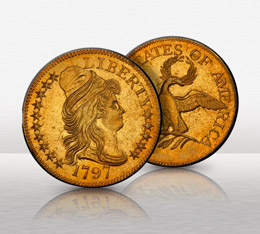 6. 1863 $10 Liberty Deep Cameo PR64: This coin is one of the most elusive American rarities in all grades. Civil War era gold proof coins represent a trophy that only a fortunate few are able to claim ownership of. Owning such a coin is indeed a triumph for a collector that now owns a piece of important American history.
6. 1863 $10 Liberty Deep Cameo PR64: This coin is one of the most elusive American rarities in all grades. Civil War era gold proof coins represent a trophy that only a fortunate few are able to claim ownership of. Owning such a coin is indeed a triumph for a collector that now owns a piece of important American history.
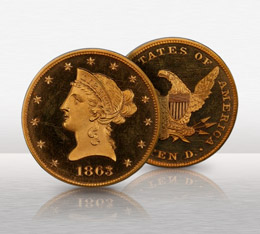 7. 1808 $2.50 Capped Bust AU58: This Quarter Eagle is a stunningly beautiful example of early American coinage and is considered one of the most important pieces of early American numismatic history.
7. 1808 $2.50 Capped Bust AU58: This Quarter Eagle is a stunningly beautiful example of early American coinage and is considered one of the most important pieces of early American numismatic history.
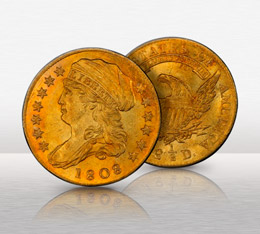 8. $5 Bechtler 128 Grain AU58: This legendary, privately minted coin carries with it a rich history of the North Carolina gold rush in the 1820’s, featuring inherent rarity and precious metal value.
8. $5 Bechtler 128 Grain AU58: This legendary, privately minted coin carries with it a rich history of the North Carolina gold rush in the 1820’s, featuring inherent rarity and precious metal value.
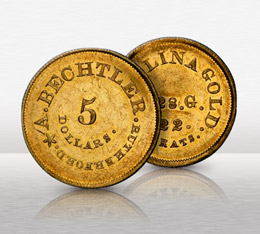 9. 1805 $5 Draped Bust MS65: The memorable design, created by Robert Scot, highlights the essence of our young nation’s aspirations and ideals. Its rarity, historical significance and elegant design make it a prized addition to any collection.
9. 1805 $5 Draped Bust MS65: The memorable design, created by Robert Scot, highlights the essence of our young nation’s aspirations and ideals. Its rarity, historical significance and elegant design make it a prized addition to any collection.
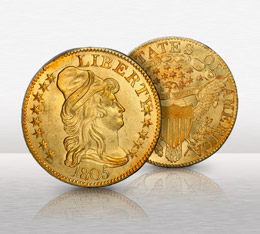 10. 1796 $10 Draped Bust AU58: This gold piece is highly prized, due in large part to its original mintage of just over 4,100 pieces. Today, survival estimates for all grades total a mere 150.
10. 1796 $10 Draped Bust AU58: This gold piece is highly prized, due in large part to its original mintage of just over 4,100 pieces. Today, survival estimates for all grades total a mere 150.
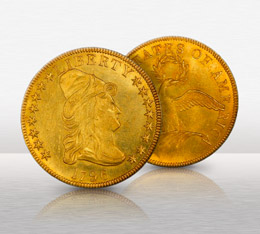
Investor Confidence and Wealth Building
Investors are increasingly confident in the stability, peace of mind and wealth preservation opportunities that precious metals and rare coins offer. Investors view these investments as part of a steady, long-term wealth-building strategy, adding to their portfolios whenever possible. Steady accumulation of rare coins and bullion has proven to be the most successful approach to building wealth over the long term.
The rare coin and the bullion markets continues to thrive, driven by increasing demand, limited supply, and a shift in global financial strategies. Investors and collectors alike can find confidence in the historical and financial value that rare coins and gold bring to their portfolios.
If you desire to build wealth for yourself and future generations, Blanchard can help you achieve your goals. Over the past 40 years, we have helped clients invest in American numismatic rarities and investment grade silver, gold, platinum and palladium bullion to protect and grow their wealth. We can help you too.
Want to read more? Subscribe to the Blanchard Newsletter and get our tales from the vault, our favorite stories from around the world and the latest tangible assets news delivered to your inbox weekly.
New Year Means It’s Time to Rebalance Your Portfolio
Posted onIf you are like many investors, your portfolio is on cruise control. Consider this: when is the last time you checked your allocation levels between say stocks, bonds, and precious metals?
The stock market posted healthy gains in 2024. But, it’s important to remember those numbers you see on your stock market brokerage account are just “paper gains.” It’s not an actual profit until you exit the investment and lock in the gains.
That’s right. Until you actually hit the button to sell out a portion of your stock position in a “rebalancing” effort, those stock gains are just a paper profit that could disappear fast in the next market swoon or bear market.
Now is a great time to lock in some of those stock market paper profits through rebalancing.
What is rebalancing?
Rebalancing simply means selling assets that have pushed outside of your allocation level. For example, if you planned to allocate 70% of your portfolio to stocks, that amount could stand at 75% now. That means you may be taking on more risk that you intended to.
As John Bogle once said: “If you have trouble imagining a 20% loss in the stock market, you shouldn’t be in stocks.”
You will need to rebalance back to your baseline allocation target. It is as simple as selling five percent of your stock allocation and using those funds to add a five percent allocation to precious metals.
While you may still want to have exposure to stocks, adding or increasing your allocation to physical gold can benefit your portfolio over the long-term. You can download an independent research report detailing long-term performance of gold and rare coins here. The results may surprise you.
Rebalancing helps you keep your portfolio on track for your goals and objectives. Rebalancing brings your portfolio back into alignment so you can sleep easy at night.
Why precious metals?
Gold acts as an insurance policy, a hedge against equity market declines and a vehicle to protect and grow wealth. Blanchard recommends that its clients allocate 10-15 percent of their investment portfolios to gold. However, it’s notable that recent research has shown that portfolios with a 30% allocation to physical gold have shown better overall long-term performance. When the equities markets falter, gold performs strongly which is why diversification is important in the first place.
We can help
It may seem like a chore, but taking a few hours to shore up your portfolio may be one of the most important things you do in the New Year. If you want advice or help in the process, one of the Blanchard portfolio managers will be happy to answer your questions and help you devise a strategy appropriate for your personal financial situation and goals. Give us a call today!
Want to read more? Subscribe to the Blanchard Newsletter and get our tales from the vault, our favorite stories from around the world and the latest tangible assets news delivered to your inbox weekly.
5 Steps to Identifying Rare Sacagawea Coins
Posted onSacagawea, an iconic figure from the Lewis and Clark Expedition, holds a prominent place in American history and numismatics. Since her image first appeared on U.S. coinage in 2000, Sacagawea dollars have been widely distributed, but not all are created equal. Some stand out as exceptionally rare and highly sought-after by collectors. This piece will answer the question “How do you know if you have a rare Sacagawea coin?” and uncover:
- A step-by-step guide to identifying rare Sacagawea coins
- The most sought-after Sacagawea coin variations
- Where to buy rare Sacagawea coins online
Watch this captivating video to dive deeper into Sacagawea’s remarkable story:
Sacagawea, The True Story – The Lemhi Shoshone Guide of the Lewis and Clark Expedition
How to tell if a Sacagawea coin is rare?
Determining if a Sacagawea coin is rare involves careful inspection of its unique features, production errors, and historical variations. Rare Sacagawea coin value can be significant, as these coins honor Sacagawea’s pivotal role in guiding the Lewis and Clark Expedition, a defining moment in U.S. history.
Coins can gain value due to their scarcity, specific minting anomalies, or limited-edition designs. These are the key steps to identifying rare specimens, ensuring you know what to look for in your collection.
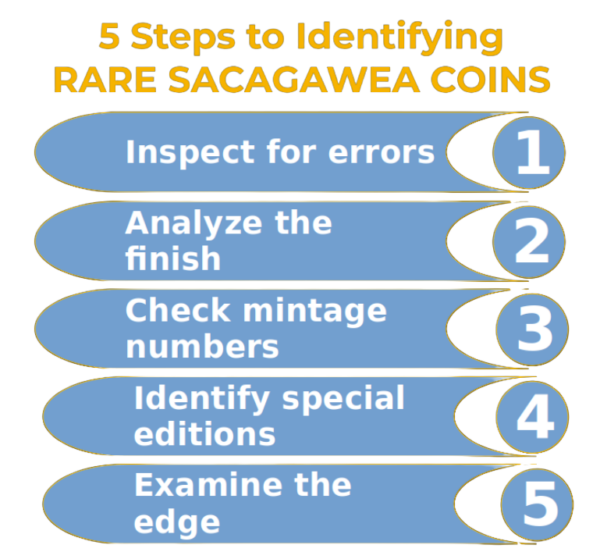
1. Inspect for errors to spot a rare Sacagawea dollar coin
Minting errors often create the most valuable pieces in numismatics. What makes the Sacagawea coin rare often comes down to these distinctive production flaws that escaped quality control.
Start by using a magnifying glass under bright, natural light to examine every detail of your coin. Common valuable errors in Sacagawea dollars include doubled dies, where design elements appear duplicated; off-center strikes, where the image isn’t perfectly centered; and missing edge lettering.
Pay particular attention to Sacagawea’s face and the eagle on the reverse – these detailed areas often reveal the most notable errors. Specific areas to examine include feather details in Sacagawea’s hair, the baby’s features, and the flowing design elements.
2. Analyze the finish to find a rare Sacagawea coin
One of the answers to the question “What to look for in a rare Sacagawea coin?” is surface quality. The U.S. Mint issued several distinct finishes, with proof and satin finishes being less common than the standard circulation finish. Proof coins are known for their mirror-like fields and frosted design elements, while satin finishes offer a soft, smooth appearance. These collector-grade versions are rarer than business strikes, making them more valuable.
Examine the coin’s luster, which should have a consistent golden sheen without discoloration or spotting. Contact marks, especially on high-relief areas like Sacagawea’s cheek or the eagle’s wings, can reduce value. A coin with its original mint luster intact is much more desirable.
3. Check mintage numbers for a valuable rare Sacagawea coin
While many collectors focus on finding a rare 1-dollar coin Sacagawea is on, true rarity often lies in a specific year. Some years saw significantly lower mintage numbers, making those coins harder to find and more valuable.
Start by checking the mint mark to identify the coin’s production location and year. Certain years were only issued in special mint or proof sets, never making it into regular circulation. Also, coins minted at the Philadelphia (P) or Denver (D) facilities can have large differences in availability. Keeping a mintage guide is helpful, as it reveals patterns of scarcity.
4. Identify special editions of your Sacagawea rare coin
Special editions and commemorative versions of coins often carry premium value. For example, what makes the 2000 Sacagawea coin rare often relates to specific variants produced that year. One significant variety is the 2000-P Cheerios dollars, included in specially marked cereal boxes as a promotion. These early strikes show subtle die differences in the tail feathers of the eagle, distinguishing them from regular issues.
Beyond the 2000 releases, look for burnished versions, enhanced uncirculated specimens, and proof strikes. Some years featured signature sets including coins with special mint marks or distinctive packaging.
5. Examine the edge for Sacagawea dollar coin rare traits
Another answer to “How rare are Sacagawea coins in my collection?” lies in the coins’ edges. The standard edge should display a distinctive golden color with reeded patterns running perpendicular to the coin’s face.
While most Sacagawea dollars feature standard reeding, certain errors resulted in missing or doubled edge details. Look for signs of incomplete reeding, unusual spacing, or missing sections. These can indicate valuable strike errors.
Use a magnifying glass to examine the edge under strong light, rotating the coin slowly to catch any irregularities. The metal composition should appear uniform. Any separation or peeling could indicate a rare plating variation.
The Sacagawea coin: Rare exemplars
First minted in 2000, the Sacagawea dollar has become a significant part of U.S. numismatic history. While many Sacagawea dollars are common, a select few stand out due to their rarity, errors, or special design features, making them highly sought-after by collectors. Below are five rare examples that highlight the fascinating variations in this coin series.
1. A rare Sacagawea coin (2000 P) with a special status
When it comes to rare Sacagawea coins selling for $5,000 or more, the 2000-P Sacagawea Goodacre Presentation dollar must be mentioned. A unique special-strike coin designed by Glenna Goodacre, this coin was part of a limited mintage given to the artist as payment for her design work.
These coins feature an unburnished finish and were struck with great care, distinguishing them from regular circulation strikes. Only 5,000 of these coins were minted, and they remain highly sought-after due to their pristine condition and connection to the artist.
Sacagawea Goodacre Presentation Dollar
- Metal: Copper
- Year: 2000
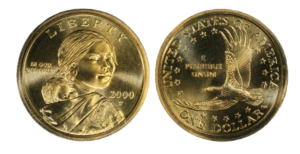
Photo by PCGS
2. One of the rarest Sacagawea dollar coin specimens
The 2000 Sacagawea Dollar/Washington quarter mule is a remarkable error coin that features the obverse of the Sacagawea dollar and the reverse of a Washington quarter. Only a few of these specimens exist, making it one of the rarest modern U.S. coins. This error likely resulted from a die mix-up at the Mint, and the unusual combination makes it a standout among numismatic collectors.
With significant rare Sacagawea dollar coin value, this coin, like other rare Sacagawea coins with errors, can be highly desirable to collectors. Some of these coins have fetched impressive sums at auction.
Sacagawea Dollar/Washington Quarter Mule
- Metal: Copper
- Year: 2000
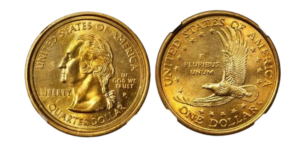
Photo by CoinWeek
3. A rare 2000-P Sacagawea dollar coin with an error
The 2000-P Sacagawea dollar struck on an Anthony dollar planchet is a rare and fascinating error. This unique coin features the Sacagawea dollar design but with the size and metal composition of the earlier Susan B. Anthony dollar. The mix-up during production resulted in an interesting and highly collectible piece. Errors like this one, just like a rare no-date Sacagawea coin with errors, are highly prized for their rarity and distinctiveness.
Sacagawea Dollar on an Anthony Dollar Planchet
- Metal: Copper
- Year: 2000
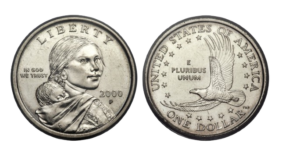
Photo by Heritage Auctions
4. An exceptionally rare 2000 D Sacagawea one-dollar coin
The rare Sacagawea coin (2000-D)/South Carolina quarter mule is another stunning error coin. Similar to the Washington quarter mule, this error blends the obverse of the Sacagawea dollar with the reverse of the South Carolina state quarter. Only a single example of this mule error has been discovered, adding to its allure and making it a one-of-a-kind piece in the numismatic world.
Sacagawea Dollar/South Carolina Quarter Mule
- Metal: Copper
- Year: 2000
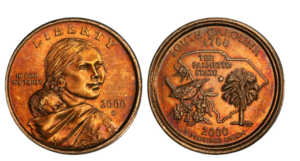
Photo by PCGS
5. The rare Cheerios Sacagawea dollar coin
The Cheerios rare Sacagawea coin, distributed as part of a promotional campaign in 2000, is a standout due to its enhanced detail on the eagle’s tail feathers, which differs from the regular design. Only 5,500 of these coins were included in the Cheerios boxes, and many have been lost. Today, high-grade examples can command significant premiums.
Sacagawea “Cheerios” Dollar
- Metal: Copper
- Year: 2000
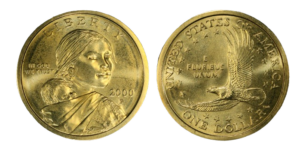
Photo by PCGS
To browse through more rare dollar coins (Sacagawea or assorted) and other valuable rare specimens, click here.
FAQ about rare Sacagawea dollar coins
Sacagawea coins are commonly circulated and not typically considered rare, which makes it easy to overlook their potential value. Certain variations, however, are highly sought-after by collectors. Identifying these can unlock opportunities for finding valuable specimens that stand out from the rest, making the pursuit of rare Sacagawea coins both exciting and rewarding.
Whether you’re evaluating a coin for its rarity or considering adding it to your collection, expertise and professional guidance are key. Blanchard is an excellent resource for navigating the complexities of rare coin collecting, offering the best selection of high-value, rare coins on the market. If you’re curious about Sacagawea rare coin value or need further assistance with expanding your numismatic portfolio, don’t hesitate to contact Blanchard at any time.
Are Sacagawea coins rare?
Most Sacagawea dollars aren’t rare, but certain varieties, errors, and special editions can be valuable collector’s items.
What makes a Sacagawea $1 coin so rare?
Minting errors, special finishes, and strikes are some of the factors contributing to certain Sacagawea dollars’ rarity.
What is rare about the 2000 P Sacagawea coin?
The 2000-P features multiple valuable varieties, including the Goodacre Presentation coins, the sought-after “Wounded Eagle” variety with its distinctive chest feather pattern, and the remarkable Quarter Mule error.
What makes 2000 D Sacagawea coin rare?
The 2000-D Sacagawea coin is rare primarily because of its production error. This occurred when a Sacagawea dollar was mistakenly struck with the reverse design of a South Carolina quarter. The result is an extremely rare and valuable coin due to the unusual combination of designs.
What is the rarest Sacagawea coin?
One of the rarest Sacagawea coins is the 2000-P Cheerios dollar which was part of a limited edition of 5,500 Sacagawea dollars placed in Cheerios cereal boxes as a marketing promotion.
How can I tell if my Sacagawea coin is rare?
To determine if your Sacagawea coin is rare, check for minting errors, special finishes, unique die variations, and research mintage numbers.
Want to read more? Subscribe to the Blanchard Newsletter and get our tales from the vault, our favorite stories from around the world and the latest tangible assets news delivered to your inbox weekly.
Fed’s Gold Dip Equals Buying Opportunity for Investors
Posted onFed Slashes Its Key Interest Rate for the Third Time This Year 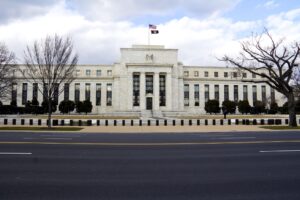
The Federal Reserve cut its benchmark interest rate by a quarter of a percentage point on Wednesday, pushing it down to 4.25% to 4.5%.
The stock market fell after the Fed’s announcement and gold dipped modestly. Precious metals weakened as the Fed signaled that it would only cut rates twice in 2025, versus the previously signaled four interest rate cuts.
Wednesday’s interest rate cut marked the third reduction in monetary policy this year as central bankers attempt to support the labor market and economic growth. However, inflation has remained above the Fed’s target rate of 2% and recently has shown signs of climbing again. The central bank’s fight against inflation is far from over.
The big news from the Fed today were the central banker’s forecast for 2025 rate cuts. In September, the central bank had penciled in four rate cuts next year – today they expect only two – as the sticky battle against inflation continues.
The central bankers adjusted today’s policy statement to reflect a slower pace of rate cuts ahead with a new phrase saying “the extent and timing” of further action would depend on the economic outlook.
Dissent at the Fed
Notably, not all 12 central bankers agreed that the Fed should slash rates today. Cleveland Fed President Beth Hammock voted against today’s interest rate cut. Earlier this month, he stated that “we are at or near the point where it makes sense to slow the pace of rate reductions,” Hammock.
Inflation Simmering Hot
Policy makers are watching inflation which has been inching higher recently. In fact, the latest November Consumer Price Index (CPI) report revealed the biggest monthly jump in seven months. The core CPI rose 0.3% to a 3.3% annual rate.
Inflation has come down from the 9.1% peak in June 2022, but the Fed is finding it difficult to fully tame the inflation genie and return it to the central bank’s 2% target.
What does this mean for gold?
The initial knee-jerk reaction on Wednesday from short-term traders pushed gold lower amid the Fed’s forecast for fewer-than-expected rate cuts next year.
But with inflation still rising, gold will continue to catch a bid. Through 2024’s record-breaking rally in gold, market dips have been short-lived and used as buying opportunities by long-term investors.
Buy the dip
Indeed, Bank of America, who expects the gold rally to continue in 2025 with a target at $3,000 an ounce, is on the record advising its clients to buy gold on price retreats. Their advice? If gold drops below $2,500 – buy it.
However, given the strong investor demand, a clip toward that level is unlikely to emerge and buyers need to be nimble and jump in the market quickly to accumulate gold while it is on sale. Lower gold prices mean investors can trade fewer dollars for more gold.
Even more inflation ahead?
Peering into the crystal ball for 2025 there are policy proposals on the table that could boost inflation even more, including tariffs and mass deportations that could mean the businesses could face a labor shortage and need to offer higher wages to attract workers. This adds up to increased demand for gold as investors search for proven strategies to lock in their purchasing power, while growing their wealth.
If you’ve been waiting to buy gold…
This year has been an extraordinary year for gold and with inflation yet to be vanquished, today’s dip in gold prices offers long-term investors a short-term opportunity to accumulate and add to their wealth protection at lower prices. If you’ve been waiting to buy gold, don’t wait too long – these lower prices won’t last.
Want to read more? Subscribe to the Blanchard Newsletter and get our tales from the vault, our favorite stories from around the world and the latest tangible assets news delivered to your inbox weekly.
Heading into 2025: Inflation Still Hotter Than Fed’s Target
Posted onThis won’t come as a surprise to Americans who are still battling high prices for everyday goods— official inflation numbers are still above the Federal Reserve’s 2% target.
The latest November Consumer Price Index (CPI) report revealed the biggest monthly jump in seven months. Consumer prices climbed 0.3% in November to 2.7%, while the core rate—which excludes food and energy rose 0.3% to a 3.3% annual rate. Big price increases for eggs and beef helped pushed inflation higher.
Report card for the Fed? Progress toward the elusive 2% target has stalled, and gone in the opposite direction. Inflation is climbing again.
It’s true that inflation has come down from the generational high at 9.1% in June 2022, but the last mile back to the Fed’s 2% target has been a battle that the central bank is losing for now.
Food and Housing Still Pinching Americans
Everything just costs more. Americans know firsthand that since 2019 prices are higher on everything from bacon, ham, coffee, eggs, frozen orange juice, ground beef, rice, sugar and wheat bread. Shelter costs, more commonly known as rent or mortgages, climbed another 0.3% in November. For the year, shelter costs have climbed 4.7%
2025 Could Bring Fresh Headwinds for Even More Inflation
Meanwhile, the changing of the guard at the White House in January could open the door to another wave of inflation. Many economists view economic policies like widespread tariffs, tax cuts and the deportations of millions of illegal immigrants as inflationary. That means that the CPI could continue to inch higher in 2025 if these policies are enacted.
What this Means for Gold Investors
Despite a modest pullback in November, gold is still on track to deliver its best annual performance in more than a decade, with gains of over 25% since the start of the year. Looking into 2025, new record-breaking rallies in gold are forecast with gains above $3,000 an ounce. What’s keeping gold bulls in the driver’s seat? It’s not just elevated inflation that is boosting gold’s appeal, but the geopolitical uncertainties and the growing focus on our nation’s debt problems.
The universe of gold investors expanded rapidly in 2024 with physical gold purchases going mainstream. One of the more popular investment strategies has been to accumulate fractional gold on an on-going basis. Fractional gold includes coins like a 1/10 ounce American Gold Eagle coin which can be purchased at an attractive price point. We are seeing investors actively building a portfolio of these lower cost gold pieces.
The Fed still hasn’t gotten inflation under control, which means that your dollars are worth less each month. The recent price dip in gold means you can buy more gold with your dollars right now. If you are interested in learning if this strategy could be right for you, talk with a Blanchard portfolio manager today. We’re here to help.
Want to read more? Subscribe to the Blanchard Newsletter and get our tales from the vault, our favorite stories from around the world and the latest tangible assets news delivered to your inbox weekly.







